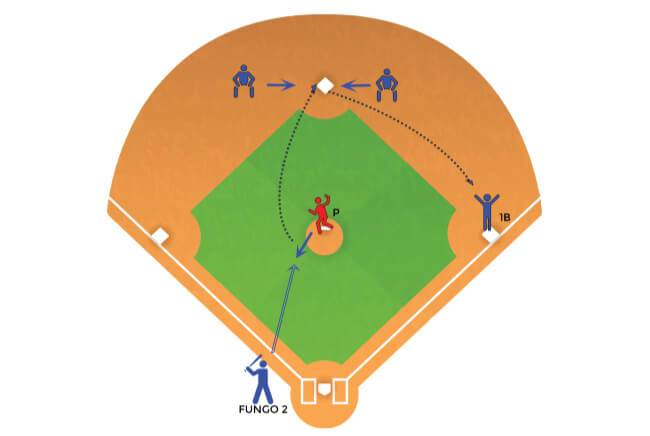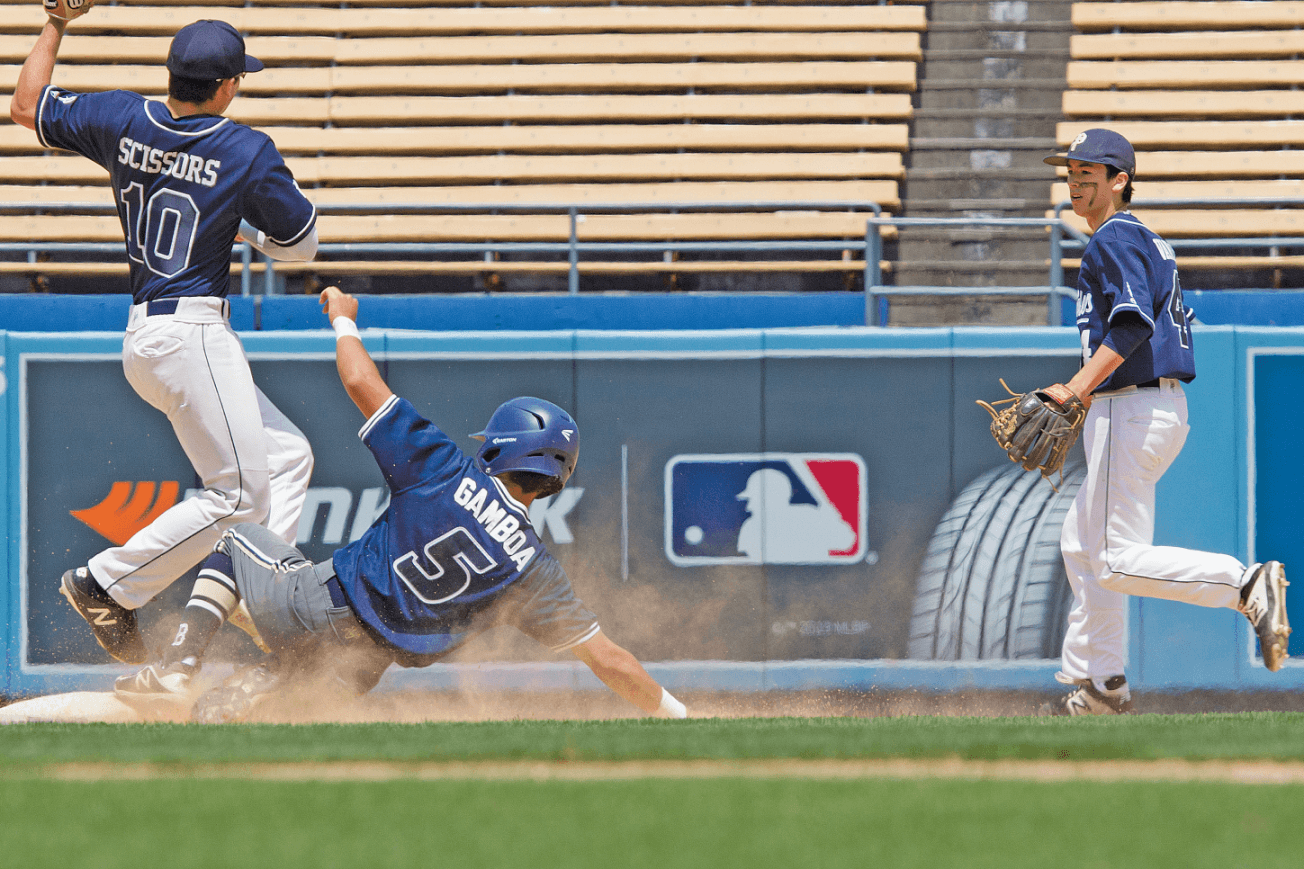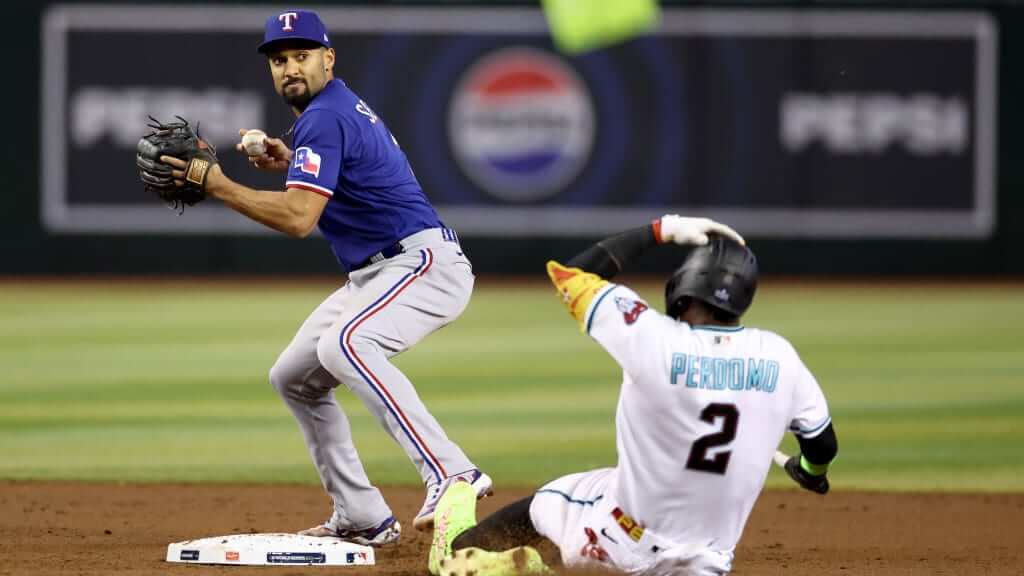A double play is one of the most exciting and pivotal defensive plays in baseball. It involves getting two outs on the same play, hence the name “double play.” Executing a clean double play can get a team out of a jam and quickly shut down a scoring threat. The double play has been part of baseball since the early days of the sport in the 19th century.
The concept of the double play is simple – there must be a force out at two bases on the same play. This usually happens when there is a runner on first base with less than two outs. The batter hits the ball on the ground to an infielder, who tosses it to the second baseman or shortstop to force out the runner coming from first. The fielder then throws it to first base to get the batter-runner for the second out. Just like that, two outs are recorded on one play.
While the basics are straightforward, turning two seamlessly requires tremendous coordination, speed, and athleticism. The double play is a fundamental part of baseball strategy for teams on defense. When pulled off properly, it can deflate the offense’s momentum in an instant. The ability to turn double plays consistently is a hallmark of strong defensive teams throughout baseball history. Some clubs have even earned nicknames like “Tinkers to Evers to Chance” for their superb double play combinations. For over a century, the twin killing has thrilled fans while challenging the reflexes and teamwork of infielders.
How a Double Play Works

A double play is a fielding play consisting of two outs recorded during the same continuous action.
Here is the typical sequence of events that leads to a double play:
-
A batter hits the ball into fair territory, either in the infield or outfield.
-
A fielder catches or fields the ball and throws it to another fielder covering the base where the lead runner is trying to advance. This is usually an infielder like the second baseman or shortstop covering second base.
-
The fielder catching the initial throw steps on second base to force out the lead runner advancing from first.
-
The fielding team then attempts to throw the ball to first base before the batter who hit the ball can reach it.
-
If successful, this results in two outs being recorded from the one continuous play.
The key defenders that typically start a double play are the pitcher, catcher, second baseman, shortstop, and first baseman. Common double play combinations involve the shortstop fielding the ball and throwing to the second baseman covering second base, who then throws it to the first baseman. The precise order of throws depends on where the ball is hit and which bases the runners are trying to advance.
Smooth transfers and quick, accurate throws are essential for turning a double play successfully. The fielders need to execute the sequence of catches and throws without dropping the ball or making a poor throw. The twin killing, as it’s sometimes called, requires solid defense and fundamentals.
Common Double Play Situations

One of the most common double play situations occurs when there is a runner on first base and the batter hits a ground ball to an infielder. The infielder fields the grounder and tosses it to the player covering second base, who steps on the base to force out the runner coming from first. The fielder covering second then throws the ball to first base in time to get the batter out too, completing the double play.
Another frequent double play scenario is when there is a runner on first and the batter hits a line drive that is caught by an infielder or outfielder. The fielder catches the ball for the first out and then throws it to the player covering second base before the runner can tag up. This line drive double play doesn’t require a throw to first base.
Finally, one of the trickiest double play chances arises when there is a runner on third base and the batter hits a ground ball to the pitcher. The pitcher fields the grounder and throws home to the catcher, who tags out the runner trying to score from third. The pitcher then throws to first or gets the out himself for the second out of the double play. This is an example of a 1-2-3 double play.
Turning Two
The art of turning a quick double play requires precise coordination and skill between the shortstop and second baseman. These defenders must have quick hands to receive the ball from the pitcher or third baseman, nimble footwork to avoid baserunners, and strong throwing arms to fire the ball to first base ahead of the runner. The ability to ‘turn two’ on a ground ball can get a team out of a jam and end an opponent’s rally.
Some of the most famous double play combinations showcased incredible chemistry from constantly working together. The Chicago Cubs duo of shortstop Joe Tinker and second baseman Johnny Evers executed slick double plays in the early 20th century. Their ability to turn two helped lead the Cubs to several World Series titles. Other iconic double play pairs include Detroit’s Alan Trammell and Lou Whitaker, who played together for 19 seasons. The New York Yankees’ duo of Derek Jeter and Robinson Cano dazzled fans with their smooth flips, pivots, and catches.
The mark of a truly great double play combination is making the difficult look routine. They quickly read and react to ground balls, flipping the ball between their gloves before firing it to first base. The shortstop and second baseman become an extension of each other, their movements in sync as they glide across the infield dirt. A split second of hesitation can be the difference between recording two outs and none. The art of the double play involves soft hands, quick transfers, and strong throws – all executed in the blink of an eye.
Double Play Records

Professional baseball features many noteworthy records related to turning double plays.
Some key career records include:
-
Most Double Plays Turned in a Career: Omar Vizquel holds the MLB record with 1,734 double plays turned over his 24-year career from 1989 to 2012. Known for his defensive prowess at shortstop, Vizquel led the league in double plays turned three times.
-
Most Consecutive Seasons Leading League in Double Plays: Bill Russell holds the record with 8 straight seasons leading the National League in double plays turned as shortstop for the Los Angeles Dodgers from 1973-1980.
-
Most Double Plays Turned by a Second Baseman: Bill Mazeroski of the Pittsburgh Pirates turned more double plays than any other second baseman, with 1,706 over his 17-year career from 1956-1972. He set the single season record for a second baseman with 161 double plays in 1966.
-
Most Double Plays Turned by a Third Baseman: Brooks Robinson has the record for third basemen with 618 double plays for the Baltimore Orioles during his 23-year career from 1955-1977.
Some single season records include:
-
Most Double Plays Turned in One Season: The Chicago Cubs hold the team record for most double plays turned in a single season with 216 in 1940.
-
Most Consecutive Games Turning a Double Play: Jimmy Rollins holds the record by turning a double play in 88 consecutive games as shortstop for the Philadelphia Phillies in 1999.
There are also some unusual records related to double plays, like most consecutive games participating in a double play (Cal Ripken Jr. – 427 games) and most seasons leading a league in double plays turned (Omar Vizquel – 11 seasons). Overall, double play records showcase some of baseball’s legendary defensive players over the decades. The ability to consistently turn two has always been a prized skill.
Preventing Double Plays
One of the main objectives for the offensive team is to prevent the defense from turning double plays. There are various baserunning tactics that can be used to help break up potential double plays.
-
The lead runner should try to get as good of a jump as possible when attempting to steal a base. This disrupts the timing of the defense and can prevent the fielder from having time to throw to start a double play.
-
Sliding into a base can also help break up double plays. The runner should slide directly into the fielder receiving the throw, as long as it is done legally and not considered interference. This can cause the fielder to hurry the throw or not even attempt the throw to complete the double play.
-
When there is a ground ball hit, the baserunners should run hard through first base or run inside the baseline. This forces the fielder to move and alter their throwing angle. It also eliminates the chance for the fielder to casually step on the base for the force out before throwing to another base.
-
The hitter can also help prevent double plays by running hard down the line on ground balls. Even running just a step or two harder can be the difference between beating out a throw.
-
There are specific rules about interference that runners must follow to legally break up double plays. They cannot intentionally slap or kick the ball out of a fielder’s hand. They also cannot run outside of the direct pathway to the base in order to make contact with the fielder. Doing so would result in the runner being called out.
Employing these running and sliding tactics at the right times can help the offense avoid those momentum-killing double plays. It’s an essential part of applying pressure on the defense and generating more scoring opportunities.
Notable Double Plays

Some of the most memorable double plays in MLB history have occurred during the playoffs or World Series, extinguishing rallies and energizing teams.
These clutch twin-killings often make the highlight reels for years to come:
-
The “Miracle Mets” turned a crucial 5-4-3 double play from Agee to Harrelson to Clendenon in Game 5 of the 1969 World Series. This rally-killer helped preserve their lead against the Orioles as the Mets went on to complete the upset.
-
Kirk Gibson hit into an around-the-horn 5-4-3 double play that ended a threat in the bottom of the 9th during Game 1 of the 1988 World Series. The Dodgers still won the game but this big double play took the pressure off Oakland’s closer.
-
The Cubs infamously blew Game 6 of the 2003 NLCS after the Marlins turned a double play on Miguel Cabrera’s grounder in the 8th inning of a 3-3 tie. This pivotal twin-killing killed Chicago’s rally right before the Marlins’ 8th inning rally.
-
In Game 7 of the 2016 World Series, Rajai Davis hit into a 6-4-3 double play in the bottom of the 8th after the Indians tied the game. This rally-killer stopped Cleveland’s momentum cold right before the Cubs’ 10th inning heroics.
-
The Astros completed a key 4-6-3 double play started by Alex Bregman in the top of the 9th inning of Game 5 during the 2017 World Series. This clutch twin-killing ended a Dodgers’ threat with the score tied and helped send the game to extra innings.
Double Play Strategy
Fielders and managers utilize various strategies to turn more double plays or prevent the offense from completing them. On defense, positioning is crucial – the shortstop and second baseman will play closer to second base when a double play is expected. The first baseman also holds runners close to prevent them from advancing too far off the base.
There are times when conceding the double play is strategically wise. With a runner on first and no outs, hitting into a double play allows the runner to advance to second base while making two outs. This can set up scoring opportunities with runners on second and third and two outs. Managers may call for hit and runs or bunt attempts to catch the defense off guard to reduce double play chances.
Defensive shifts have become more popular as teams use data to position fielders where batters typically hit. Shifts can both increase and decrease double play opportunities. When the third baseman plays close to shortstop in an overshift, the left side of the infield is better positioned to turn two. But shifts also leave vacated areas that give batters a higher chance of hitting into the outfield.
Rotations, defensive positioning, and situational awareness are pivotal in double play strategy. Teams are constantly looking for ways to turn two when on defense and avoid the rally killing twin killing when batting.
Changing Rules

Baseball rules governing double plays have changed over the years, impacting how often they occur and the strategy involved. In the early days of baseball, fielders could simply tag the lead runner to record an out on a force play, without having to throw to a base. This made it much easier to turn double plays. However, in the 1880s, the rules changed to require throws to bases, increasing the difficulty.
Other key rule changes like introducing new base running lanes in the 1930s, restrictions on takeout slides in the 1970s, and time limits for runners to advance to first base in the 2010s have all subtly shifted double play dynamics. For instance, the takeout slide restrictions made it harder for base runners to break up double plays through physical contact with fielders. However, limits on catchers blocking the plate opened a window for runners to avoid tag outs.
Teams and players have adapted strategies around double plays amidst changing rules. Infielders master quicker pivots and transfers to pull off lightning fast twin killings. Runners learn techniques like the hook slide to legally avoid tags. While double plays look different than they did in early baseball, they remain an integral part of the game’s strategy and excitement. The evolution of rules has shaped their execution, while maintaining their central role.
Importance of the Double Play
The double play is one of the most important defensive plays in baseball. While not as flashy as a home run or diving catch, the ability to turn two efficiently is a key skill for infielders and can have a huge impact on the outcome of a game. There are several reasons why the double play is so valuable:
Win Probability Added
Research has shown that successfully completing a double play increases a team’s probability of winning by around 10%. The two outs recorded on one play allows a pitcher to face one less batter in the inning, preserving a lead or keeping the game tied. Those extra 10 percentage points are significant when every out matters late in a close game.
Game Control
In addition to the mathematical win probability boost, double plays help control the pace and momentum during a game. After allowing a runner to reach base, quickly flipping two provides a sense of order that stifles a potential rally. The defense immediately wrestles back control of the inning by swiftly erasing multiple baserunners. This rapid turnaround can deflate an opponent’s growing confidence.
Momentum Shifts
A timely double play can completely swing the momentum of a game. If the home team turns two to escape a jam in front of a raucous crowd, the energy in the ballpark noticeably shifts. Fans are re-engaged, teammates are fired up, and pitchers feel rejuvenated. Meanwhile, the visiting players often seem deflated by seeing a prime scoring chance evaporate so swiftly. The double play’s ability to abruptly change a game’s tenor is one of its most thrilling attributes for viewers.
So while the double play lacks the highlight-reel appeal of other defensive plays, its strategic importance makes it one of baseball’s pivotal plays. The ability to efficiently turn two is a core skill that all championship-caliber teams must possess.








